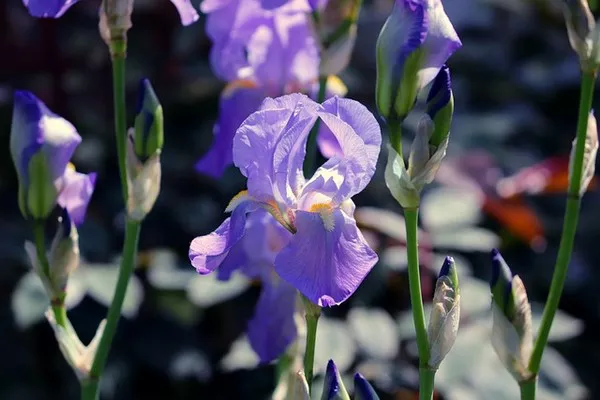In the vast tapestry of botanical beauty, few colors captivate the human eye quite like the regal shade of purple. From royal gardens to wild meadows, purple flowers add a touch of elegance and mystique to the natural landscape. This comprehensive guide delves into the enchanting world of purple flowers, exploring their diverse species, unique characteristics, and the symbolism they carry.
The Allure of Purple Flowers
1. The Color Spectrum:
Purple, nestled between the calming blues and passionate reds on the color spectrum, embodies a perfect balance of serenity and vitality. Flowers boasting this hue come in a myriad of shades, from delicate lavender to deep, velvety plum, offering a versatile and rich palette for floral enthusiasts.
2. Symbolism and Significance:
The color purple has long been associated with royalty, luxury, and sophistication. In the language of flowers, purple blooms often convey sentiments of admiration, enchantment, and mystery. Understanding the symbolic meanings behind these blossoms adds depth to the appreciation of their aesthetic appeal.
Popular Varieties of Purple Flowers
1. Lavender (Lavandula spp.):
Known for its soothing fragrance and delicate spikes of tiny blossoms, lavender is a perennial favorite in gardens worldwide. This aromatic herb not only adds a touch of purple elegance but also serves various practical purposes, such as attracting pollinators and repelling pests.
2. Purple Tulips (Tulipa spp.):
Tulips, with their graceful, cup-shaped petals, bloom in a spectrum of colors, including captivating shades of purple. These springtime beauties symbolize perfect love and are a popular choice for gardens, floral arrangements, and even special occasions like weddings.
3. Iris (Iris spp.):
The iris, named after the Greek goddess who connected gods to humanity, boasts a unique structure and a captivating range of purple hues. These graceful flowers are not only visually stunning but also carry a symbolic significance of faith, wisdom, and courage.
4. Purple Orchids (Orchidaceae):
Orchids, a symbol of exotic beauty and refinement, exhibit a wide array of colors, including enchanting shades of purple. With their intricate shapes and patterns, purple orchids are often associated with luxury, royalty, and admiration.
5. Purple Roses (Rosa spp.):
Roses, the epitome of romance, are not confined to the traditional red. Purple roses, with their velvety petals, convey a sense of enchantment and mystery. These blooms make a unique and elegant statement in gardens and floral arrangements alike.
6. Bellflowers (Campanula spp.):
Bellflowers, also known as campanulas, feature bell-shaped blossoms in various shades, including delightful purples. These charming perennials are perfect for borders, rock gardens, or hanging baskets, adding a whimsical touch to any landscape.
7. Allium (Allium spp.):
Known for their distinctive spherical clusters of tiny flowers, alliums are members of the onion family that come in shades of purple. These ornamental bulbs bring a contemporary and architectural element to gardens, attracting pollinators and adding a burst of color.
Cultivating and Caring for Purple Flowers
1. Soil and Sunlight:
Understanding the specific needs of each purple flower variety is crucial for successful cultivation. While some thrive in full sunlight, others prefer partial shade. Similarly, soil preferences may vary, with some species thriving in well-draining soil and others requiring more moisture.
2. Watering and Fertilization:
Proper watering and fertilization are essential for the health and vitality of purple flowers. Overwatering can lead to root rot, while insufficient watering may result in stunted growth. Additionally, choosing the right fertilizer and applying it at the correct times can enhance blooming and overall plant vigor.
3. Pruning and Deadheading:
Regular pruning and deadheading help maintain the aesthetic appeal of purple flowers and promote healthy growth. Removing spent blossoms encourages the plant to redirect energy towards producing new blooms, prolonging the flowering season.
4. Companion Planting:
Strategic companion planting can enhance the overall well-being of purple flowers by attracting beneficial insects, repelling pests, and improving soil quality. Understanding the principles of companion planting allows gardeners to create harmonious and thriving ecosystems.
Conclusion
In conclusion, the world of purple flowers is a captivating realm filled with diversity, symbolism, and natural beauty. From the classic allure of lavender to the exotic elegance of orchids, each variety brings its own charm to gardens and floral arrangements. By exploring the enchanting world of purple flowers and understanding their unique characteristics, enthusiasts can cultivate not only vibrant gardens but also a deeper appreciation for the profound symbolism these blooms carry. Embrace the regal charm of purple flowers, and let their hues transform your outdoor spaces into a tapestry of botanical elegance.


